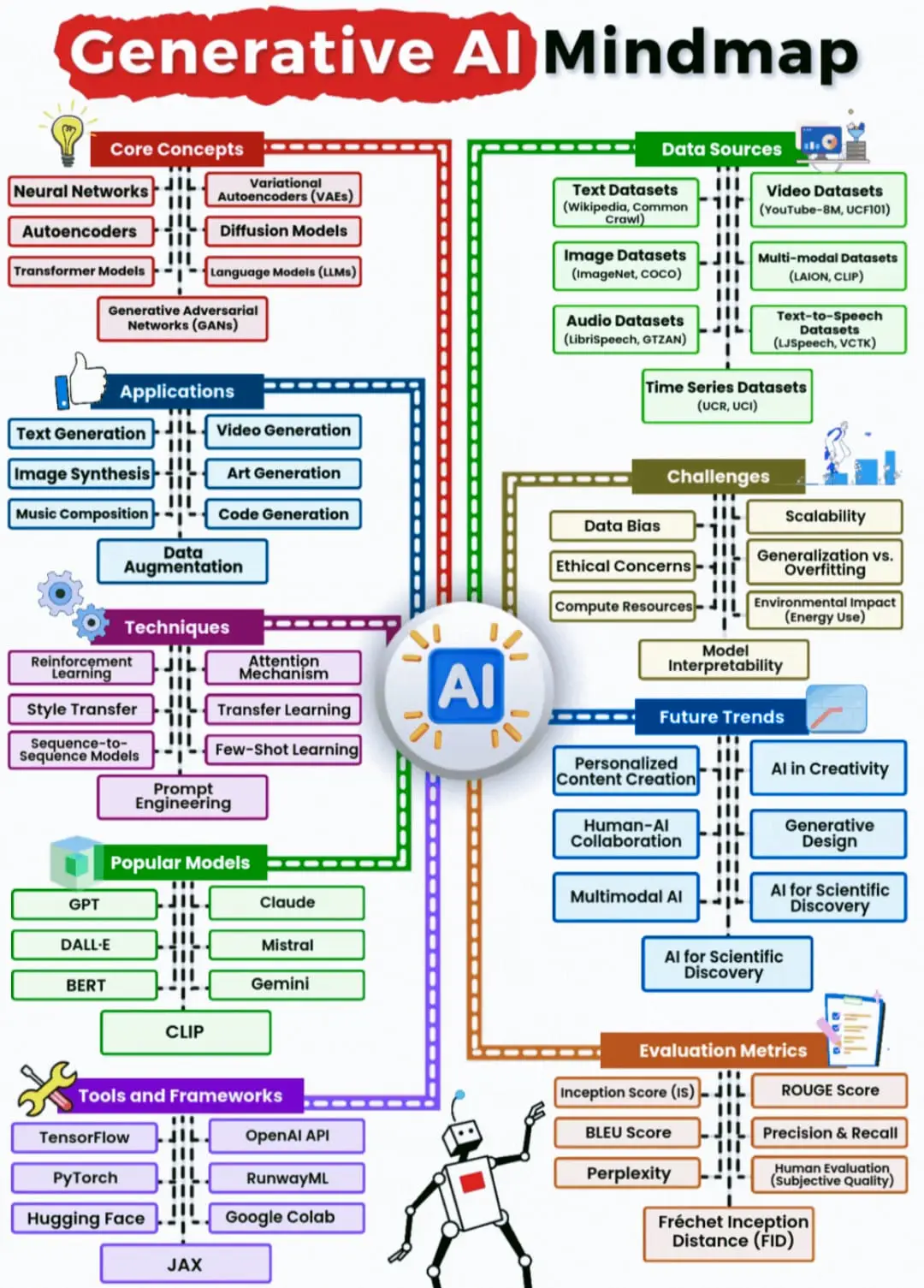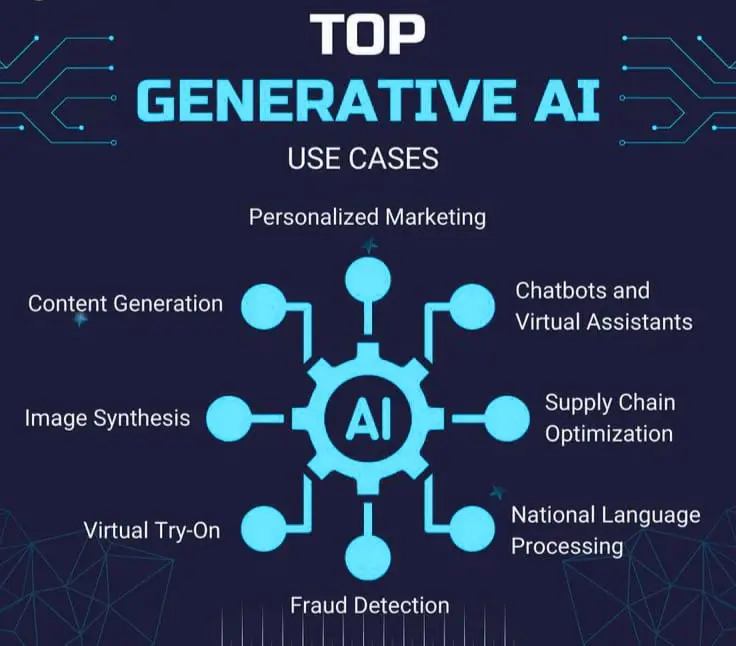The Definitive Guide to Generative AI: Exploring the Revolution
Learn how to build any software with AI
The Updated 1st batch of the world’s most enabling course on AI. Learn how to build anything with AI.
Generative AI (GenAI), a groundbreaking field within artificial intelligence, is rapidly transforming how we create, interact with, and perceive content. From crafting compelling narratives and stunning visuals to composing music and designing innovative products, generative AI tools are unlocking unprecedented creative potential. This comprehensive guide delves into the mechanics of generative AI, explores its diverse applications across industries, examines its inherent benefits and limitations, and navigates the crucial ethical considerations surrounding this revolutionary technology.
What is Generative AI? Demystifying the AI Content Creation Revolution
Generative AI is a class of artificial intelligence algorithms designed to generate new, original content. This content can manifest in various forms, including text (articles, poems, code), images (photorealistic scenes, abstract art), audio (music, speech), video (deepfakes, animations), 3D models, and even synthetic data used for training other AI systems. While the core concept of AI-generating content has existed for decades, recent advancements in deep learning, particularly the development of powerful neural networks, have propelled generative AI into the mainstream. The ability of these models to produce high-quality, often indistinguishable from human creations in mere seconds has ignited both excitement and apprehension, signaling a paradigm shift in content creation and consumption.
A Journey Through Time: A Brief History of Generative AI's Evolution
While generative AI’s current prominence seems sudden, its roots extend back to the mid-20th century. Early attempts at automated content generation involved rule-based systems and expert systems. However, these approaches lacked the flexibility and sophistication of modern techniques. A pivotal moment arrived in 2014 with the introduction of Generative Adversarial Networks (GANs). GANs, comprised of two competing neural networks (a generator and a discriminator), revolutionized image generation, enabling the creation of remarkably realistic images and videos. The subsequent rise of transformers, a novel neural network architecture, and the development of large language models (LLMs) like GPT-3 and beyond, have further fueled the generative AI revolution, unlocking its potential for text, code, and other complex data types.
How Does Generative AI Work? Unveiling the Magic Behind AI Content Creation
At its core, generative AI operates on the principle of learning patterns and structures from vast datasets of existing content. These datasets can include text, images, audio, code, or any other form of data. The AI model analyzes this data, identifying underlying relationships and representations. Once trained, the model can then generate new content that adheres to the learned patterns. The process typically begins with a “prompt,” which can be a text description, an image, a melody, or any other input that guides the content generation process. The AI model then uses this prompt as a starting point to create new, original content. Modern generative AI tools often provide user-friendly interfaces, allowing individuals without deep technical expertise to interact with these powerful models through natural language prompts and intuitive controls. Users can further refine the generated content by providing feedback and adjusting parameters like style, tone, and complexity.
The Powerhouse Behind the Magic: GANs, VAEs, Transformers, and Diffusion Models
Several key architectures power the current wave of generative AI:
* Generative Adversarial Networks (GANs): GANs consist of two neural networks, a generator that creates new content and a discriminator that evaluates the authenticity of the generated content. These networks are trained in a competitive process, with the generator striving to create increasingly realistic content and the discriminator trying to distinguish between real and generated content.
* Variational Autoencoders (VAEs): VAEs learn a compressed representation of the input data, allowing them to generate new content by sampling from this latent space. They are particularly effective for generating variations of existing content.
* Transformers: Transformers are a type of neural network architecture that excels at processing sequential data, such as text and code. Their ability to capture long-range dependencies and understand context has made them instrumental in the development of LLMs.
* Diffusion Models: Diffusion models work by gradually adding noise to data until it becomes pure noise, and then learning to reverse this process to generate new data. They have become a leading approach for generating high-quality images.
The Titans of Generative AI: Exploring Leading Platforms and Tools
The generative AI landscape is constantly evolving, with new tools and platforms emerging regularly. Some of the most prominent players include:
* OpenAI’s DALL-E 2 and Imagen: These models generate images from text descriptions, enabling users to create stunning visuals with simple prompts.
* OpenAI’s ChatGPT and GPT Models: These powerful language models can generate human-quality text, translate languages, write different kinds of creative content, and answer your questions in an informative way.
* Google’s Gemini and PaLM 2: Google’s suite of generative AI models, including Gemini, are capable of understanding and generating text, code, and images.
* Midjourney and Stable Diffusion: These platforms offer user-friendly interfaces for generating AI art, making creative expression accessible to a wider audience.
Use Cases Across Industries: Transforming Businesses and Creative Fields
Generative AI is rapidly permeating various sectors, impacting how businesses operate and how creative professionals work:
* Marketing and Advertising: Generating targeted ad copy, creating personalized marketing materials, and producing engaging social media content.
* Content Creation: Automating the creation of articles, blog posts, scripts, and other forms of written content.
* Software Development: Generating code, automating bug fixes, and assisting with software design.
* Product Design: Creating new product prototypes, generating design variations, and optimizing product performance.
* Entertainment and Gaming: Generating realistic game assets, creating immersive virtual worlds, and developing interactive narratives.
* Healthcare: Analyzing medical images, generating synthetic data for training medical AI models, and personalizing treatment plans.
* Finance: Detecting fraud, generating financial reports, and personalizing financial advice.
The Power and the Perils: Benefits and Limitations of Generative AI
Generative AI offers numerous potential benefits:
* Increased Efficiency: Automating content creation processes, freeing up human creators for more complex tasks.
* Enhanced Creativity: Unlocking new avenues for creative expression and exploration.
* Personalization: Creating personalized experiences for users across various domains.
* Innovation: Driving innovation in various industries by enabling the rapid prototyping and testing of new ideas.
However, generative AI also presents certain limitations:
* Bias and Fairness: Generative AI models can inherit and amplify biases present in their training data, leading to unfair or discriminatory outcomes.
* Accuracy and Hallucinations: Generative AI models can sometimes generate inaccurate or nonsensical content, known as “hallucinations.”
* Copyright and Ownership: Questions surrounding copyright ownership of AI-generated content remain complex and unresolved.
* Misinformation and Deepfakes: The ability to generate realistic fake content raises concerns about the spread of misinformation and the potential misuse of deepfakes.
Navigating the Ethical Maze: Responsible Development and Deployment of Generative AI
The ethical implications of generative AI are profound and require careful consideration. Key ethical challenges include:
* Transparency and Explainability: Understanding how generative AI models arrive at their outputs is crucial for ensuring accountability and trust.
* Privacy: Generative AI models trained on personal data raise privacy concerns.
* Job Displacement: The automation potential of generative AI raises concerns about job displacement in certain sectors.
* Responsible Use: Developing guidelines and best practices for the responsible use of generative AI is essential to mitigate potential harms.
The Future of Generative AI: A Landscape of Possibilities
Generative AI is still in its nascent stages, and its future potential is immense. As technology continues to evolve, we can expect to see even more sophisticated applications emerge, transforming industries and reshaping how we interact with technology. Addressing the ethical concerns and limitations will be crucial to ensuring the responsible development and deployment of this powerful technology, paving the way for a future where generative AI empowers creativity, fosters innovation, and benefits humanity as a whole.
* Generative AI
* AI content creation
* AI art generator
* AI image generation
* AI text generation
* Large language models (LLMs)
* AI models
* Deep learning
* Artificial intelligence
* What is generative AI?
* How does generative AI work?
* Generative AI applications
* Generative AI tools
* Best generative AI platforms
* Generative AI for marketing
* Generative AI in healthcare
* Ethical considerations of generative AI
* Future of generative AI
* Generative AI vs. other AI
* AI content generator
* AI writing tools
* AI image generators free
* AI music generation
* AI video generation
* Generative AI platforms
* DALL-E 2
* ChatGPT
* Gemini AI
* Stable Diffusion
* Midjourney
* AI powered content creation
* AI content creation tools
* Machine learning
* Neural networks
* Deepfakes
* Misinformation
* Bias in AI
* Copyright and AI
* AI ethics
* Innovation
* Digital transformation


